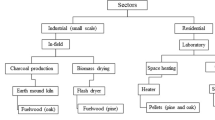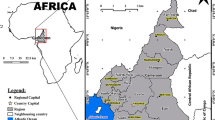Abstract
The aim of this study is to analyse the economic viability of cooking biomass briquettes made from coconut shells, rattan waste, banana peels, and sugarcane bagasse by replacing conventional fuels such as fuelwood, charcoal and Liquefied Petroleum Gas (LPG). The life cycle cost method and the sensitivity analysis based on a 10-year lifetime are applied to a typical Cameroonian household with an annual cooking energy requirement of 950 kWh. According to the results, briquettes made from coconut shells have the lowest life cycle cost (384.6€), while those made from banana peels have the highest cost (729.6€). The fuelwood replacement has the highest present value of net benefit. Among the three conventional fuels investigated, wood charcoal is the cheapest. Changes in the price of conventional fuels and the market discount rate affect the economic feasibility of biomass briquettes. With the exception of the banana peel briquettes, briquettes are more cost-effective than fuelwood, wood charcoal and Liquefied Petroleum Gas. Decision makers should consider ways to include massive household use of biomass briquettes in sustainable development because they could be a leading mover in sustainable development.






Similar content being viewed by others
Abbreviations
- CCS:
-
Coconut shells
- PVT :
-
Present Value at the year T, €
- RWT:
-
Rattan waste
- d:
-
Discount rate, %
- BNP:
-
Banana peels
- Ed :
-
Energy demand, kWh
- SGC:
-
Sugarcane bagasse
- ACT :
-
Annual cash flow at the year T, €
- IEA:
-
International Energy Agency
- FC:
-
Fuel Cost, €/kwh
- WHO:
-
World Health Organization
- INV:
-
Initial investment cost, €
- LPG:
-
Liquefied Petroleum Gas
- i :
-
Fuel cost inflation rate, %
- PVNB:
-
Present Value of Net Benefit, €
- j :
-
Maintenance cost inflation rate,%
- LCC:
-
Life Cycle Cost, €
- PVT :
-
Present Value at the year T, €
- LCCconv :
-
Life Cycle Cost of conventional fuel, €
- d:
-
Discount rate, %
- LCCbio :
-
Life Cycle Cost of biomass briquette, €
- MC:
-
Maintenance cost, €
- kWh:
-
Kilowatt-hour
- kWht :
-
Kilowatt-hour thermal
References
Halder, P.K., Paul, N., Beg, M.R.A.: Assessment of biomass energy resources and related technologies practice in Bangladesh. Renew. Sustain. Energy Rev. 39, 444–460 (2014). https://doi.org/10.1016/j.rser.2014.07.071
Wirba et al, “Renewable energy potentials in Cameroon : Prospects and challenges .,” Renwable Energy, 2016.
E. Atyi et al., “Étude de l’importance économique et sociale du secteur forestier et faunique au Cameroun: Rapport final,” 2013.
WHO, “Indoor Air Pollution: Multiple Links between Household Energy and the MDGs,” 2011.
Kpalo, S.Y., Zainuddin, M.F., Manaf, L.A., Roslan, A.M.: A review of technical and economic aspects of biomass briquetting. Sustain 12, 11 (2020). https://doi.org/10.3390/su12114609
Mboumboue, E., Njomo, D.: Potential contribution of renewables to the improvement of living conditions of poor rural households in developing countries : Cameroon ’ s case study. Renew. Sustain. Energy Rev. 61, 266–279 (2016). https://doi.org/10.1016/j.rser.2016.04.003
OMS, “la pollution de l’air à l’intérieur des habitations et la santé,” 2007.
Bot, B.V., Gaston, J., Olivier, T., Sosso, T., Pascal, M.: Assessment of biomass briquette energy potential from agricultural residues in Cameroon. Biomass Convers Biorefinery (2022). https://doi.org/10.1007/s13399-022-02388-2
McKendry, P.: Energy production from biomass (part 1): Overview of biomass. Bioresour. Technol. 83(1), 37–46 (2002). https://doi.org/10.1016/S0960-8524(01)00118-3
Ngusale, G.K., Luo, Y., Kiplagat, J.K.: Briquette making in Kenya: Nairobi and peri-urban areas. Renew. Sustain. energy Rev. 40, 749–759 (2014)
Bot, B.V., Sosso, O.T., Tamba, J.G., Lekane, E., Bikai, J., Ndame, M.K.: Preparation and characterization of biomass briquettes made from banana peels, sugarcane bagasse, coconut shells and rattan waste. Biomass Convers Biorefinery (2021). https://doi.org/10.1007/s13399-021-01762-w
Lubwama, M., Yiga, V.A.: Development of groundnut shells and bagasse briquettes as sustainable fuel sources for domestic cooking applications in Uganda. Renew. Energy 111, 532–542 (2017). https://doi.org/10.1016/j.renene.2017.04.041
Sawadogo, M., Tanoh, S.T., Sidibé, S., Kpai, N., Tankoano, I.: Cleaner production in burkina faso: Case study of fuel briquettes made from cashew industry waste. J. Clean. Prod. 195, 1047–1056 (2018)
Kauter, D., Lewandowski, I., Claupein, W.: Quantity and quality of harvestable biomass from Populus short rotation coppice for solid fuel use—a review of the physiological basis and management influences”. Biomass Bioengerg. 24, 411–427 (2003)
Njenga, M., et al.: Additional cooking fuel supply and reduced global warming potential from recycling charcoal dust into charcoal briquette in Kenya. J. Clean. Prod. 81, 81–88 (2014). https://doi.org/10.1016/j.jclepro.2014.06.002
Guo, Z., et al.: Characteristics of biomass charcoal briquettes and pollutant emission reduction for sulfur and nitrogen during combustion. Fuel 272, 117632 (2020). https://doi.org/10.1016/j.fuel.2020.117632
Lubwama, M., Yiga, V.A.: Characteristics of briquettes developed from rice and coffee husks for domestic cooking applications in Uganda. Renew. energy 118, 43–55 (2018)
De Oliveira Maia, B.G., Souza, O., Marangoni, C., Hotza, D., De Oliveira, A.P.N., Sellin, N.: Production and characterization of fuel briquettes from banana leaves waste. Chem. Eng. Trans. 37, 439–444 (2014). https://doi.org/10.3303/CET1437074
Gill, N., Dogra, R., Dogra, B.: Influence of moisture content, particle size, and binder ratio on quality and economics of rice straw briquettes. Bioenergy Res. 11(1), 54–68 (2018). https://doi.org/10.1007/s12155-017-9877-9
Srivastava, N.S.L., Narnaware, S.L., Makwana, J.P., Singh, S.N., Vahora, S.: (2019) Investigating the energy use of vegetable market waste by briquetting. Renew. Energy 68, 270–275 (2014). https://doi.org/10.1016/j.renene.2014.01.047
Stolarski, M.J., Szczukowski, S., Tworkowski, J., Krzyzaniak, M., Gulczyński, P., Mleczek, M.: Comparison of quality and production cost of briquettes made from agricultural and forest origin biomass. Renew. Energy 57, 20–26 (2013). https://doi.org/10.1016/j.renene.2013.01.005
Investir au Cameroun, “Bussiness in Cameroon,” www.investiraucameroun.com, 2021.
Ishengoma, E.K., Igangula, N.H.: Determinants of household choice of cooking energy-mix in a peri-urban setting in Tanzania. Energy Sustain. Dev. 65, 25–35 (2021). https://doi.org/10.1016/j.esd.2021.09.004
Tamba, J.G.: LPG consumption and economic growth, 1975–2016: evidence from Cameroon. Int. J. Energy Sect. Manag. 15(1), 195–208 (2021). https://doi.org/10.1108/IJESM-01-2020-0005
Obi, O.F., Ezema, J.C., Okonkwo, W.I.: Energy performance of biomass cookstoves using fuel briquettes. Biofuels 11(4), 467–478 (2020). https://doi.org/10.1080/17597269.2017.1374769
Kapen, P.T., Tenkeu, M.N., Yadjie, E., Tchuen, G.: Production and characterization of environmentally friendly charcoal briquettes obtained from agriculture waste: case of Cameroon”. Int. J. Environ. Sci. Technol (2021). https://doi.org/10.1007/s13762-021-03497-7
Sakellariou, E.I., Axaopoulos, P.J., Wright, A.J.: Energy and economic evaluation of a solar assisted ground source heat pump system for a north mediterranean city. Energy Build. 231, 110640 (2021). https://doi.org/10.1016/j.enbuild.2020.110640
Sakellariou, E.I., Wright, A.J., Axaopoulos, P.J.: Energy, economic and emission assessment of a solar assisted shallow earth borehole field heat pump system for domestic space heating in a north European climate. Geothermics 95, 102159 (2021). https://doi.org/10.1016/j.geothermics.2021.102159
G. Tchatat, “Cameroun – Contribution a La Preparation Du Rapport National Pour La Formulation Du Livre Blanc Regional Sur L’Acces Universel Aux Services Energetiques Integrant Le Developpement Des Energies Renouvelables Et De L’Efficacite Energetique,” Cameroon, pp. 1–245, 2014, [Online]. Available: http://www.se4all.org/sites/default/files/Cameroon_RAGA_FR_Released.pdf.
INS, “Annuaire statistique du Cameroun, Institut National de la Statistique,” 2008.
INS, “Annuaire statistique du Cameroun, Institut National de la Statistique,” 2013.
N. Schlag and F. Zuzarte, “Market Barriers to Clean Cooking Fuels in Sub-Saharan Africa: A Review of Literature,” Fuel, no. April, pp. 1–21, 2008, [Online]. Available: http://sei-international.org/mediamanager/documents/Publications/Climate/market_barriers_clean_cooking_fuels_21april.pdf.
INS, “Agriculture. Annuaire statistique. Chapitre 13,” 2017.
Doggart, N., et al.: The influence of energy policy on charcoal consumption in urban households in Tanzania. Energy Sustain. Dev. 57, 200–213 (2020). https://doi.org/10.1016/j.esd.2020.06.002
Wiafe, E.D.: Fuel-wood usage assessment among rural households in Ghana. Spanish J. Rural Dev (2013). https://doi.org/10.5261/2013.gen1.04
Sana, A., Kafando, B., Dramaix, M., Meda, N., Bouland, C.: Household energy choice for domestic cooking: distribution and factors influencing cooking fuel preference in Ouagadougou. Environ. Sci. Pollut. Res. 27(15), 18902–18910 (2020). https://doi.org/10.1007/s11356-020-08427-7
Uhunamure, S.E., Nethengwe, N.S., Musyoki, A.: Driving forces for fuelwood use in households in the thulamela municipality, South Africa. J. Energy South. Africa 28(1), 25–34 (2017). https://doi.org/10.17159/2413-3051/2017/v28i1a1635
Acknowledgements
This work was carried out in the framework of the HIGHER EDUCATION—KA107 INTERNATIONAL MOBILITY project between University of Douala and University of West Attica, Athens, Greece. The authors acknowledge the European Union and the ERASMUS + Program [Agreement No 205] for support. Authors thank department of mechanical engineering of University of West Attica.
Author information
Authors and Affiliations
Contributions
BVB involved in conceptualisation and writing original draft; PJA involved in methodology and review and editing original draft; OTS involved in software and visualisation; EIS involved in review and editing original draft; and JGT involved in supervision and project administration.
Corresponding author
Ethics declarations
Conflict of interest
The authors declare no competing interests.
Additional information
Publisher's Note
Springer Nature remains neutral with regard to jurisdictional claims in published maps and institutional affiliations.
Rights and permissions
About this article
Cite this article
Bot, B.V., Axaopoulos, P.J., Sosso, O.T. et al. Economic analysis of biomass briquettes made from coconut shells, rattan waste, banana peels and sugarcane bagasse in households cooking. Int J Energy Environ Eng 14, 179–187 (2023). https://doi.org/10.1007/s40095-022-00508-2
Received:
Accepted:
Published:
Issue Date:
DOI: https://doi.org/10.1007/s40095-022-00508-2




